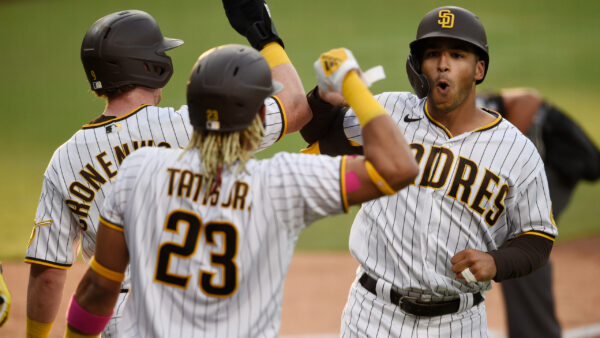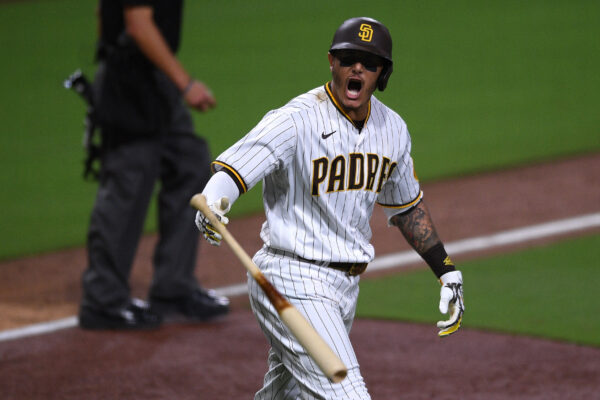How the Padres fit the current state of Major League Baseball

Credit: AP Photo

A deep look at the San Diego Padres and how they matchup among MLB’s best teams.
Roughly three months ago, I wrote an article identifying seven tenets of a healthy professional baseball organization in today’s Major League Baseball called, These are the Droids You’re Looking For.
The article laid out concepts that winning organizations employ and some trends winning teams seemed to be following. As we approach the beginning of the 2021 spring training cycle, let’s measure the San Diego Padres much-amended roster and processes with those tenets: a teacher’s common formative assessment, if you will.
According to Oddsshark.com, the Padres rate as a +750 to win the World Series this season, trailing only the defending champion Los Angeles Dodgers (+300) and the New York Yankees (+600). With a matter of days to go before Arizona and Florida start the season cycle, the Padres’ report card ratings follow:
Tenet #1: Empty the Tank in Player Scouting, Acquisition, and Development
Padres grade = A
The Padres receive high marks in identifying talent, acquiring talent, and using resources to improve the on-field product and window. Has any team used their entire system to improve the Major League roster like San Diego has? If it’s not carrying out a growing list of successful drafts, if it’s not amassing a continuous flood of recognition as the dominant Minor League system in producing Major League talent, then it’s maneuvering the Rule 5 draft and this off-season’s redacting of the minor league system. Introductory level talent holds as little value now as it ever has, and San Diego moved a ton of it to acquire win “soon” players. The yield reveals a clear three-year window where the Padres stand poised to win a World Series title. Or, three.
In terms of identifying talent, the Padres have signed players in countries worldwide where other organizations don’t even scout. AJ Preller has led the charge long in miles and short on sleep, but a cadre of characters have established themselves as reliable diamond miners. Whether the front office claims status as the very best in the industry or not sits for someone else to determine, but they certainly rate at the top of the heap with few peers.
The list of trades is dizzying. This article, written at the 2020 deadline, claims no team has ever traded like Preller’s Padres. To say the movement is unusual in baseball history is not only minimizing but misses the point. The hyper-trade mode that the Padres have employed in recent seasons maximized a farm system bearing a stash of younger prospects who may or may not become big league winners and turning it into the highest ceiling roster for a prescribed championship window. The brilliant plan gives their talent-mining organization another three years to rebuild those coffers while achieving at the highest level. Other organizations in similar situations have burned down the farm for a one-year run, only to put themselves in a multi-year tanking and rebuilding process. San Diego has moved in such a way that there should be no drop-off in coming years.
The biggest difference in these not-your-father’s Fathers rests in development. Current captain Jayce Tingler’s previous jobs in baseball deal with leading teams but also developing them. Tingler served as the Texas Rangers Major League Player Development Field Coordinator in 2019. Tingler’s in-game managerial choices stand as supportable and questionable as any MLB manager, but with Skip Schumaker, a longtime St. Louis Cardinal, assisting him, game management became a strength. The effective managerial choices in 2020 earn even greater praise when one considers Tingler’s first run. MLB rewarded him as a finalist for Major League Baseball Manager of the Year in 2020. The product on the field, its shifts, its baserunning, and its lineups all showed a growth mindset and a proficiency that develops confidence.
But, Tingler stands as only one of many leaders deserving acclaim. The Padres wisely brought difference makers to the staff in 2020 MLB Coach of the Year, Bobby Dickerson. Among other successes, he helped committed star shortstop, Fernando Tatis, Jr., become a +7 DRS player (from -13 the year before). The Padres, after years of a seeming organizational indifference, boast an ownership group and front office who finally understand and pursue what winning baseball requires. Dickerson represents several effective coaches who’ve shown a growth mindset as members come and go.
Using a terrifically un-scientific and rubric-less grading metric, the Padres earn a clear, far-from-easy A. If one started an expansion franchise, the people to put in place to build a long-term championship-level organization reside in San Diego, and who among Padres fans could have expected that?
Tenet #2: Invest in a Combination of Analytics and Feel
Padres grade = B-
Popular or not, the Houston Astros qualify as maybe the poster child of what I’ll call optimization. In How the Houston Astros Disrupted Player Development to Become the Model MLB Franchise from 2019, Ben Lindbergh and Travis Sawchik explained the organizational changes made that propelled the Astros to, among other positives a World Series title. Lindbergh and Sawchik wrote the book, The MVP Machine: How Baseball’s New Non-Conformists Are Using Data to Build Better Players, which goes a step further than the Moneyball concept of unearthing hidden talents that already exist to, instead, actually creating talents in players.

The article cites Stanford researcher Carol Dweck with the concept of a growth mindset because, as she discovered, the Astros value team members who believe their talents can be developed as opposed to those who believe they exist as finished products. They want players who exhibit a willingness to look at data and trust what it indicates even when it goes against a career’s worth of efforts.
Since implementing wide-ranging change across the organization in 2014, the Astros made the playoffs in 2015, 2017, 2018, 2019, and 2020. Could this relative team success be due to other factors? How do we know the Astros philosophy holds water?
Among other evidence, the article explains the Astros dominated the minors as much as the majors: at 6 levels of the minors, Astros pitchers led all franchises in strikeouts, and the 7th level saw them finish in second. They accomplished this while fielding the youngest average-aged players of any organization. Hitters ranked second in walk-to-strikeout ratio while finishing fourth in home runs. These two areas indicate offensive and pitching innovation and strength beyond what other teams employ. The results display the Astros flourishing while amassing the highest winning percentage of any organization in the minors across all levels. The enviable height of what it means to combine analytics with a traditional feel for the game has existed in Houston for now, heading toward a decade.
While the Padres may not wield a well-documented history of this type of innovation in their recent past, they could boast of a new emphasis on player development. The most notable evidence lies in their most recent front office, managerial, and coaching hires.
In this East Village Times article from two years ago, writer Diane Calkins noted “An Odd Fit in the Padres’ Front Office.” She detailed the hiring of a formerly critical Fangraphs voice. Managing editor and analyst Dave Cameron had hammered San Diego concerning their mishandling of medical information. He predicted a “free agent landmine” in signing Eric Hosmer, among other perceived attacks. But, wisely, Preller and the Padres convinced Cameron to join forces with them. This, among other shifts in focus at the front office level, occurred not coincidentally before the heists of players such as Trent Grisham and Jake Cronenworth. And, it speaks to the targeted acquisition of a player like Austin Nola, who had an unusual upbringing in the catching position, to say the least. Current projects may include players like Brian O’Grady, Nick Burdi, and Nabil Crismatt.
The Padres weren’t the first to honor the age of analytics, but as Detroit and Baltimore, for example, are in the earliest stages of shifting to it, they certainly aren’t last. This continues to be an area to develop with a growth mindset, but growth continues to occur.
In a decision reminiscent of your 8th-grade History teacher’s random grade determination, the Padres gain a B-.
PAGE 2 LINK BELOW
M. Robert Klemesrud, born and currently residing in the great state of Iowa, is an educator of 25 years. Having studied journalism at the University of Iowa, played baseball in the Missouri Valley, and followed the Padres religiously for over 30 years, he has found the perfect place to align some of his passions at East Village Times.
Thank you both. Unfortunately, I can only write these when I have time and inspiration for now. This summer that will change. Often, that leads to hurried pieces with at times semi-redundant sections and an occasional jaw-breaker sentence. I just re-read it and grimaced. It should be written better honestly. However, positive reinforcement is always appreciated, and relevant content exists in it. I hope we continue to have more and more reason to write and read amazing developments in Padre-land. I hope you continue to find value in the East Village Times, its writers/creators, and its content.
Mi padre’s Padres started with the ’84 pennant winners. Some of my friends donned Chicago Cubs gear as it appeared they were on their way to eclipsing their organizational drought. I hate bandwagoning in general; I made the statement, down 0-2 in the 5 game set, “If the Padres come back and win this series, I’ll be a Padres fan for life.” They won game 3; they won game 4, and game 5 sealed it. Tony Gwynn was beginning his ascent in becoming my lifelong sports hero. For a long time, his greatness was enough to overshadow the often mediocre team results. I live in the Midwest, and almost no one here has been following San Diego. So, I’m stoked that the entire baseball world seems to have no choice but to take notice of the positives that are happening.
Here’s to hoping for a 3-year run of back-to-back-to-back World Series titles.
Yes, good times. I remember wearing my Cubs buster tshirt for many days. Tony will always be Mr Padre. Fernando is the new face of the Padres and will be for many years to come. However, there was, and will be, only ONE Tony Gwynn. He was amazing. I’d like to see an article on those with the least amount of strikeouts in MLB. I doubt people even know how seldom TGwynn struck out. The best contact hitter ever in my opinion. Home runs are fun but Tony was Tony. We were usually surprised when he didn’t get a hit.
I look forward to more of your pieces.
It’s too late for me to write much, except to say, Thank you for a great write up!
That was an outstanding article. I thoroughly enjoyed the intricacy of your information. I appreciate the research you did to write such a piece.
I am the father’s father. I’ve been going to games since I was 10 in 1969. I remember all the (cough cough) lean years. I grew up idolizing Nate Colbert, Chris Cannizzaro, and others. I couldn’t wait to read the sports page when I woke up to see if they’d won the night before. How I enjoyed watching Randy Jones throwing 90 minute games for a last place team. Now… Now… we are on the precipice of being rewarded for unrewarded loyalty. To KNOW our team is positioned to compete for a title this year and for many more… it’s exciting.
Thank you for the inspiring article. I look forward to more of yours.